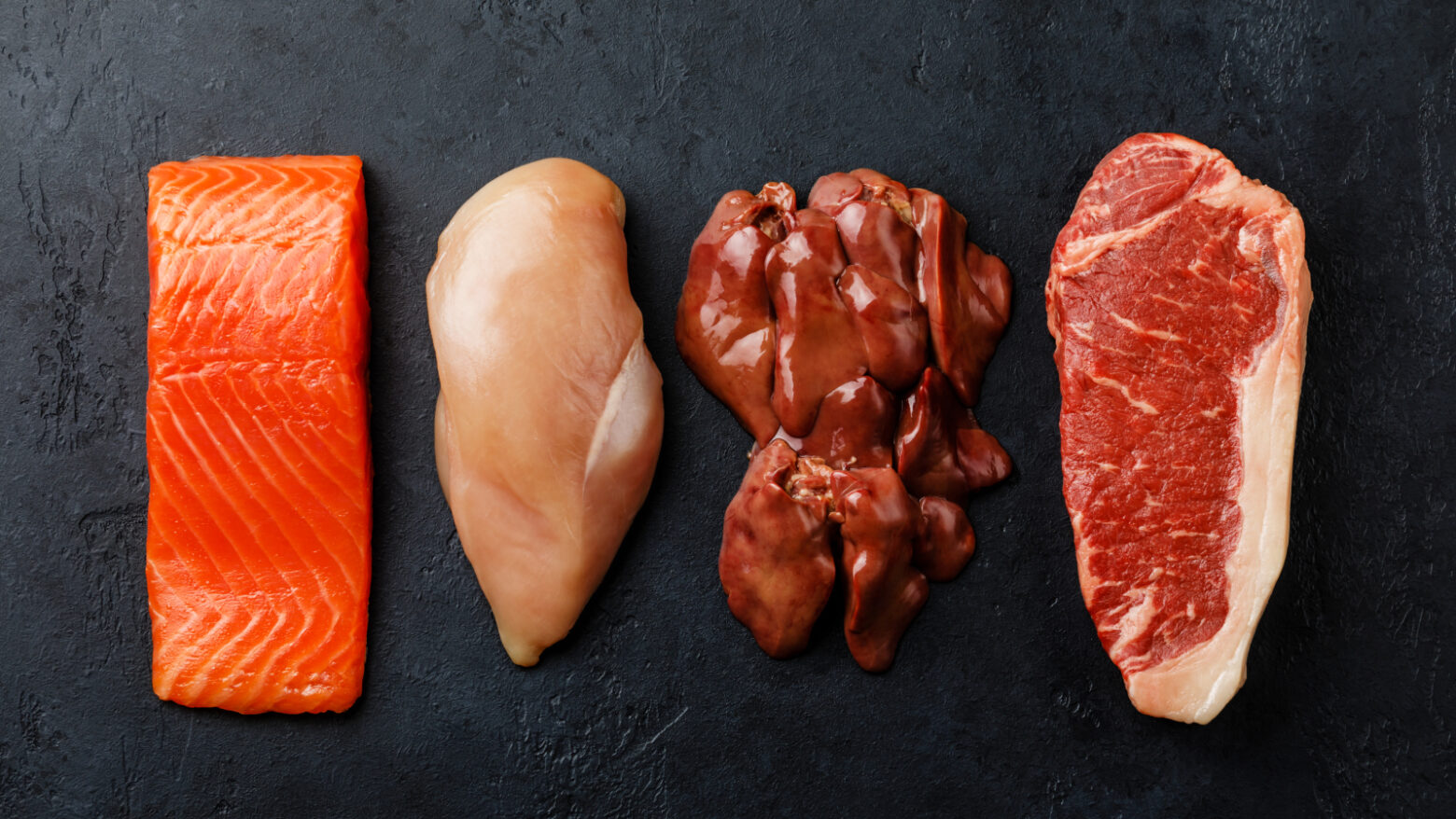The Carnivore Diet vs. The Paleo Diet

Debates over the proper human diet tend to get heated, especially when it comes to eating meat. There are arguments about why humans should or should not eat meat based on various evolutionary, biological, or ethical considerations.
On one side, vegetarians and vegans believe that (ethical reasons aside) a plant-based diet is better for you because avoiding meat prevents various cancers and heart diseases. [1] On the other end of the spectrum, those who espouse the carnivore diet believe that eliminating carbohydrates from your diet equalizes blood sugar levels, [2] stabilizes your mood and energy levels, and reduces gastrointestinal issues. Plus, some research suggests that a high-protein diet can help lower LDL (the “bad” cholesterol). [3]
In the middle of these two extremes is The Paleo Diet®, which is based on emulating eating how our ancestors ate through human evolution. [4,5] This means following a natural, well-balanced diet that includes both plants and animals.
So assuming you decide to include meat in your diet, let’s take a deeper look at both the carnivore diet and The Paleo Diet so you can compare the features of each and help you decide if one may be right for you.
What Is the Carnivore Diet?
The carnivore diet focuses on meat and animal food sources. Because the diet only allows for meat, fish, eggs, and some animal products like organs, it is naturally a very low carbohydrate diet. All other food groups are excluded, including vegetables, fruits, grains, legumes, nuts, and seeds. Drinking bone broth and water is encouraged, but beverages like tea, coffee, and other drinks made from plants are discouraged.
There is little published research that offers guidance regarding calorie intake, serving sizes, or how many meals or snacks to eat each day. The carnivore diet is also extremely low in fiber, which may cause a range of health issues. Popularized by former orthopedic doctor Shawn Baker, who feels it more closely resembles the primitive way our ancestors ate than The Paleo Diet, the carnivore diet is based on the belief that our ancestors mainly ate animal sources. Fans of the carnivore diet say it has a range of benefits from weight loss to regulated blood sugar levels and higher testosterone levels, and they believe in its potential as an anti-inflammatory diet. However, there’s limited research to support the claim that these benefits are greater on a carnivore diet compared to a balanced omnivore diet.
Carnivore vs. Paleo Diet
At first glance, the carnivore diet and The Paleo Diet seem congruent with each other because they are both higher-protein, lower-carb diets that emphasize the importance of eating whole, unprocessed foods, but there are some very marked differences between the two. The Paleo Diet encourages you to eat meat, but unlike the carnivore diet, it’s not the only thing on the plate. The carnivore diet abstains from all primary sources of carbohydrates, while The Paleo Diet allows room for plenty of complex carbs, like sweet potatoes, squash, and other fiber-rich fruits and vegetables.
And this is where the two diets really diverge.
The fact is, humans are omnivores. Research shows that, while there was a wide variance in what we ate, the majority of hunter-gatherer tribes had plant/animal dietary ratios ranging from 35:65 to 65:35. [4] This fits with the concept of hormesis—in simple terms, too much or too little of one thing isn’t good. We need to consume both animal products and vegetation, ensuring that all essential nutrients are consumed. The Paleo Diet not only looks at the foods our ancestors ate, but it also looks at what they didn’t eat: simple (processed) sugars, added salt, dairy, whole grains, and gluten.
The Beef with Red Meat
Diets that contain animal proteins have been over-stigmatized. Meat—red meat in particular—gets a bad rap. Past studies have tied it to the increased risk of diabetes, cardiovascular disease, and certain cancers. [6,7] But research shows that red meat contains important nutrients, including protein, vitamin B12, and iron, which the body needs to build muscle and bone, form red blood cells, and help the central nervous system function normally. [8] In fact, humans require B12 in order to thrive, and it can only come from animal sources.
Meat also contains creatine and carnosine, which are beneficial to the brain and muscles. [9] A serving of red meat is also a good source of zinc, which can help the body produce testosterone; [10] and selenium, a powerful antioxidant that plays a key role in metabolism.
There’s also mounting evidence that health issues arise not from the red meat itself, but from the quality of the meat. Some research suggests that the consumption of processed red meat may be associated with conditions like heart disease and diabetes. [11] High-quality grass-fed meats, on the other hand, can improve the omega-3 to omega-6 ratio (both essential nutrients your body can’t make) and natural antioxidants. [12-14]
So Which Diet Is Better?
There is some evidence that the carnivore diet can have short-term benefits for autoimmune disease, neurodegeneration, and cancer, but there are concerns about nutrient deficiencies in the long term. [15-17]
Vitamin C, for example, is an essential dietary component that’s involved in protein metabolism, and the biosynthesis of collagen, a component of connective tissue. It’s also an important antioxidant that plays a huge role in immune health. [18] Fruits and vegetables are the best sources of vitamin C. If you’re following the carnivore diet, oral supplementation may be required—though there is some evidence that carnitine in animal products can make up for the lack of this nutrient. [19]
Likewise with calcium. This mineral not only plays an important role in bone health, but it also plays a meaningful role in preventing blood clots and regulating normal heart rhythms and nerve functions. Commonly found in dairy (which both diets eschew), it’s also abundant in fruits and leafy greens, which are included in The Paleo Diet.
The carnivore diet may require careful planning and some supplementation to avoid nutrient deficiencies. But ultimately, the health impacts of the carnivore diet are hard to determine because more research needs to be done.
This is why we feel an omnivore Paleo Diet is superior. It guarantees you get the nutrients you need and requires no supplementation. A long-term diet needs to be metabolically flexible and include both animal- and plant-based foods, making The Paleo Diet better for long-term, sustained health.
References
- Key TJ, Fraser GE, Thorogood M, Appleby PN, Beral V, Reeves G, Burr ML, Chang-Claude J, Frentzel-Beyme R, Kuzma JW, Mann J, McPherson K. Mortality in vegetarians and nonvegetarians: detailed findings from a collaborative analysis of 5 prospective studies. Am J Clin Nutr. 1999 Sep;70(3 Suppl):516S-524S.
- Forsythe CE, Phinney SD, Fernandez ML, Quann EE, Wood RJ, Bibus DM, et al. Comparison of Low Fat and Low Carbohydrate Diets on Circulating Fatty Acid Composition and Markers of Inflammation. Lipids [Internet]. 2007 Nov 29;43(1):65–77.
- Yu Z, Nan F, Wang LY, Jiang H, Chen W, Jiang Y. Effects of high-protein Diet on Glycemic control, Insulin Resistance and Blood Pressure in Type 2 diabetes: a Systematic Review and meta-analysis of Randomized Controlled Trials. Clinical Nutrition. 2019 Aug;39(6).
- Cordain L, Miller JB, Eaton SB, Mann N, Holt SH, Speth JD. Plant-animal subsistence ratios and macronutrient energy estimations in worldwide hunter-gatherer diets. The American Journal of Clinical Nutrition [Internet]. 2000 Mar 1 [cited 2025 Mar 31];71(3):682–92.
- Eaton B. Paleolithic vs. modern diets–selected pathophysiological implications. European Journal of Nutrition 2000;39:67–70.
- Rohrmann S, Overvad K, Bueno-de-Mesquita HB, Jakobsen MU, Egeberg R, Tjønneland A, et al. Meat consumption and mortality – results from the European Prospective Investigation into Cancer and Nutrition. BMC Medicine 2013;11:63.
- Al-Shaar L, Satija A, Wang DD, Rimm EB, Smith-Warner SA, Stampfer MJ, et al. Red meat intake and risk of coronary heart disease among US men: prospective cohort study. BMJ 2020;371:m4141.
- Calderón‐Ospina CA, Nava‐Mesa MO. B Vitamins in the nervous system: Current knowledge of the biochemical modes of action and synergies of thiamine, pyridoxine, and cobalamin. CNS Neuroscience & Therapeutics [Internet]. 2019 Sep 6;26(1):5–13.
- Wu G. 136 Beef as a Functional Food for Improving Human Nutrition and Health. Journal of Animal Science. 2021 Oct 8;99(Supplement_3):70–1.
- Te L, Liu J, Ma J, Wang S. Correlation between serum zinc and testosterone: A systematic review. Journal of Trace Elements in Medicine and Biology [Internet]. 2023 Mar 1 [cited 2023 Jun 28];76:127124.
- Micha R, Wallace SK, Mozaffarian D. Red and Processed Meat Consumption and Risk of Incident Coronary Heart Disease, Stroke, and Diabetes Mellitus. Circulation [Internet]. 2010 Jun;121(21):2271–83.
- Cordain L, Watkins B, Florant G, Kelher M, Rogers L, Li Y. Fatty acid analysis of wild ruminant tissues: evolutionary implications for reducing diet-related chronic disease. Eur J Clin Nutr 2002;56:181–91.
- Daley CA, Abbott A, Doyle PS, Nader GA, Larson S. A review of fatty acid profiles and antioxidant content in grass-fed and grain-fed beef. Nutr J 2010;9:10.
- McAfee AJ, McSorley EM, Cuskelly GJ, Fearon AM, Moss BW, Beattie JAM, et al. Red meat from animals offered a grass diet increases plasma and platelet n-3 PUFA in healthy consumers. Br J Nutr 2011;105:80–9.
- Ho VW, Leung K, Hsu A, Luk B, Lai J, Shen SY, et al. A Low Carbohydrate, High Protein Diet Slows Tumor Growth and Prevents Cancer Initiation. Cancer Res 2011;71:4484–93.
- Gyorkos A, Baker MH, Miutz LN, Lown DA, Jones MA, Houghton-Rahrig LD. Carbohydrate-restricted Diet and Exercise Increase Brain-derived Neurotrophic Factor and Cognitive Function: A Randomized Crossover Trial. Cureus 2019;11:e5604.
- Crosby L, Davis B, Joshi S, Jardine M, Paul J, Neola M, et al. Ketogenic Diets and Chronic Disease: Weighing the Benefits Against the Risks. Frontiers Nutrition 2021;8:702802.
- Frei B, England L, Ames BN. Ascorbate is an outstanding antioxidant in human blood plasma. Proceedings of the National Academy of Sciences [Internet]. 1989 Aug 1;86(16):6377–81.
- O’Hearn A. Can a carnivore diet provide all essential nutrients? Curr Opin Endocrinol Diabetes Obes 2020;27:312–6.
Maureen Farrar
Maureen Farrar has spent more than 20 years as a writer and editor for several print and digital outlets. She writes about health, fitness and nutrition.
More About The Author


